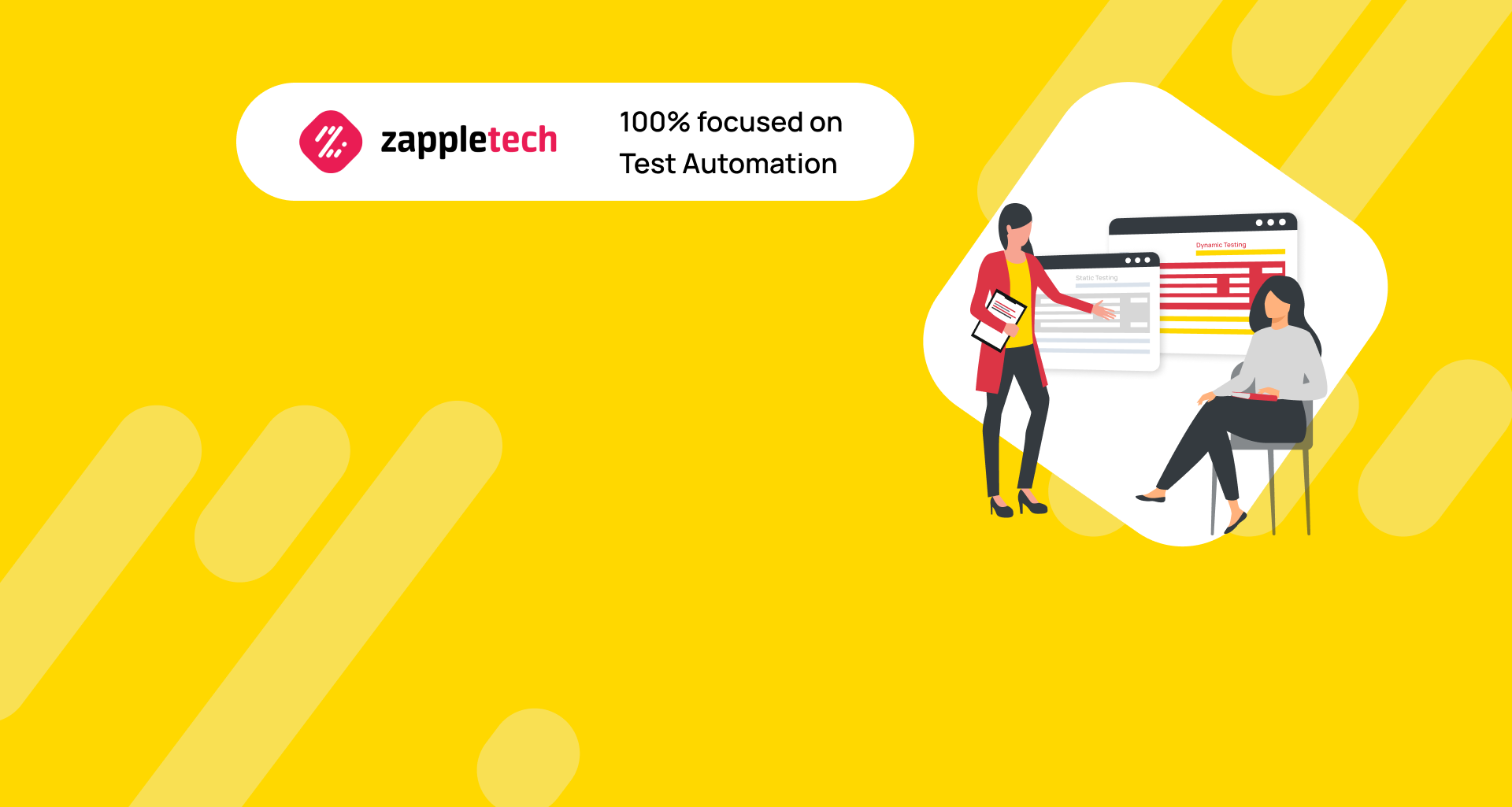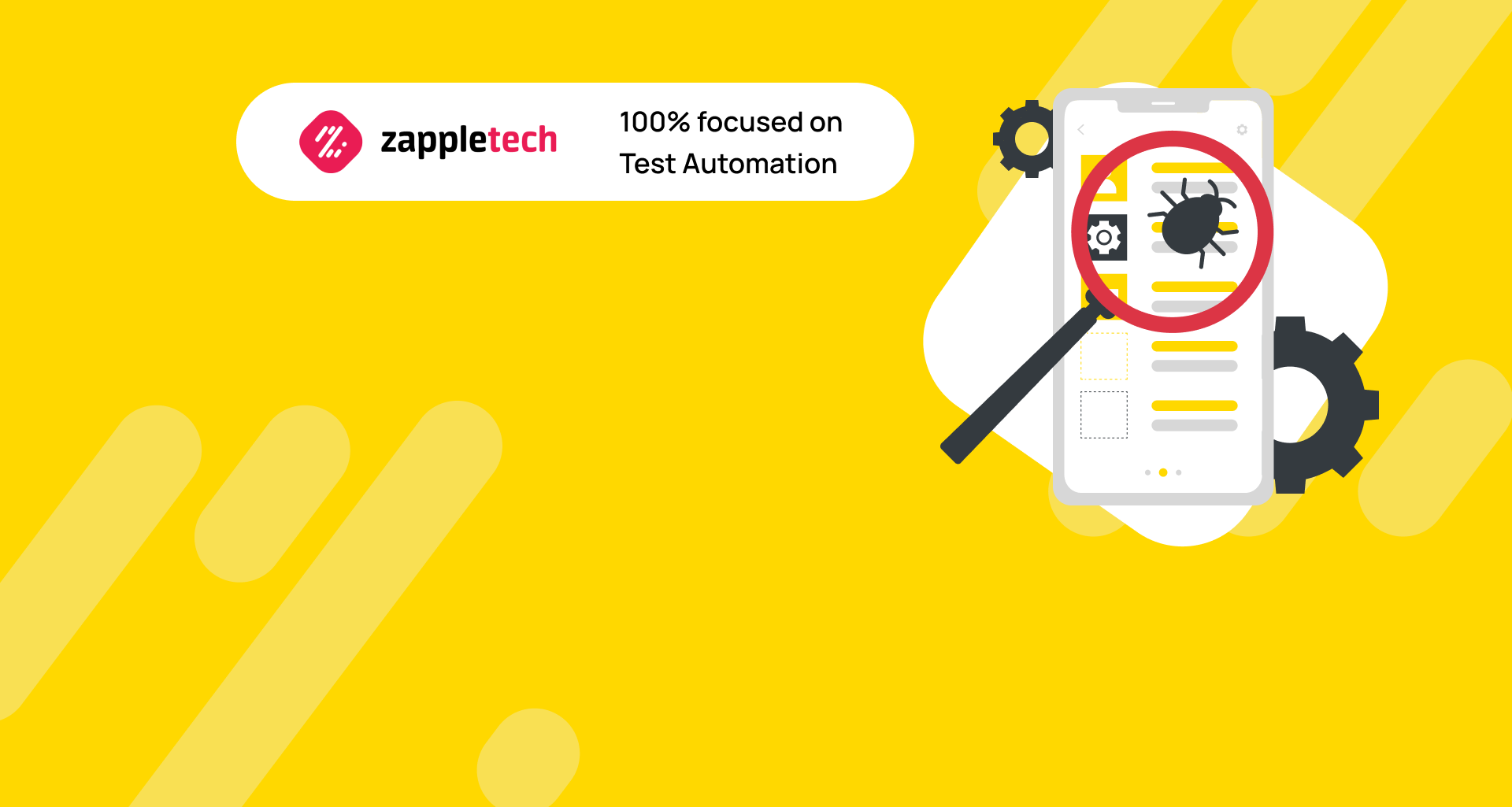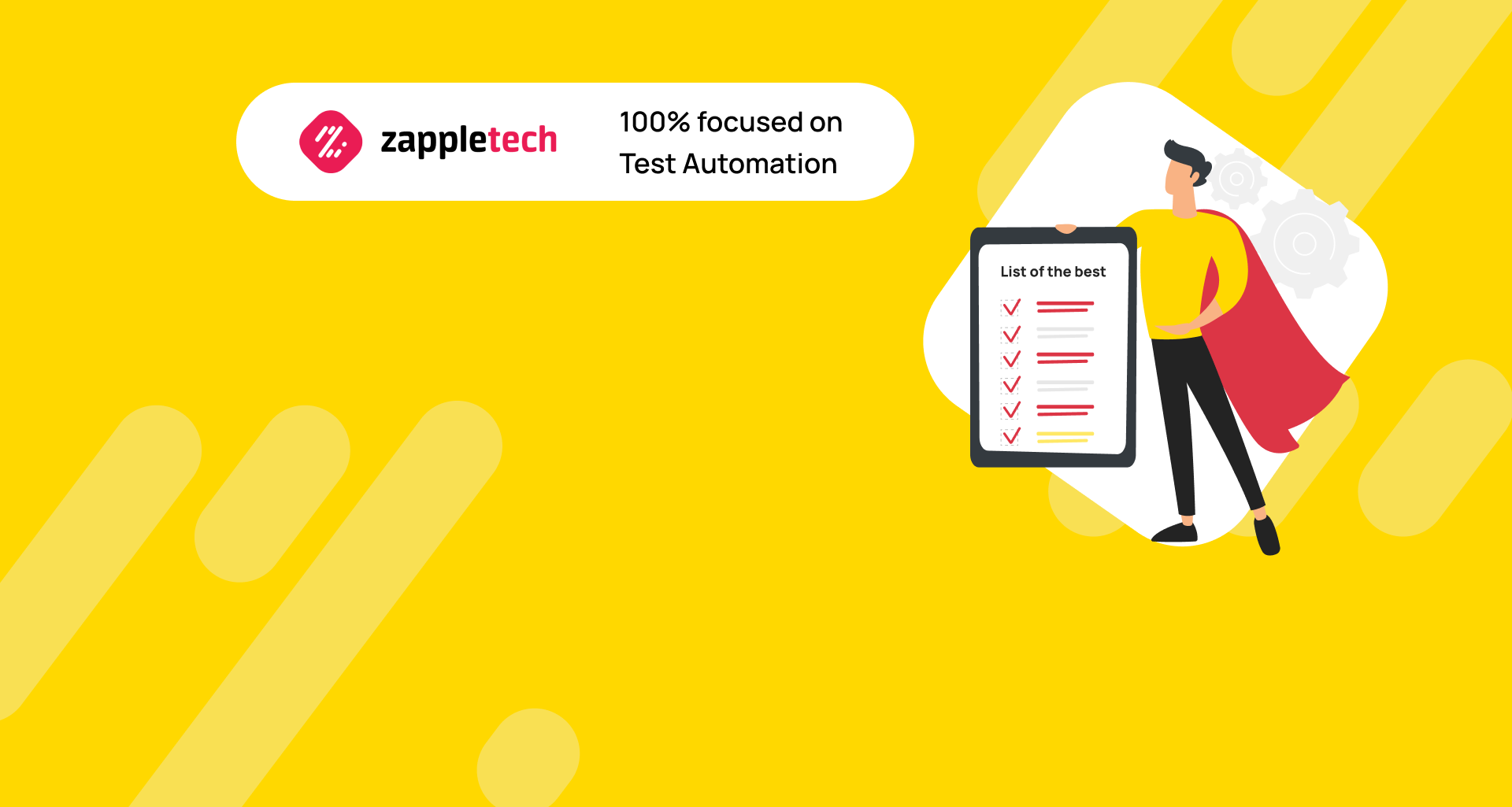To further understand the importance of quality assurance in today’s tech-driven landscape, it is essential to consider the distinction between static and dynamic testing. Static testing involves examining the code, documentation, and design without executing the program. This approach helps detect errors early in the development cycle, ensuring issues such as syntax errors, compliance with coding standards, and security vulnerabilities are addressed before the software is even run. Static testing methods, such as code reviews and static analysis tools, contribute to a more stable foundation for future development phases.
On the other hand, dynamic testing focuses on evaluating the software during execution to ensure it functions as expected in real-world scenarios. This form of testing assesses the product’s behavior under different conditions, identifying bugs, performance bottlenecks, and usability issues that static testing might miss. By integrating both static and dynamic testing into the QA process, companies can achieve a more comprehensive evaluation of their software, leading to a higher-quality end product.
With the increasing complexity of modern applications and the fast-paced nature of business, the need for rigorous testing has never been more critical. Static and dynamic testing are no longer optional but integral to delivering reliable, scalable, and secure IT solutions. Furthermore, as companies continue to invest in digital transformation initiatives, the role of these testing methodologies will only grow, becoming key drivers in ensuring the success of software in today’s competitive market.
By reviewing code, design documents, or project requirements before execution, you can catch errors early on, saving time and effort later in the development cycle.Sergey AlmyashevCOO, ZappleTech Inc.
Testing modern IT solutions involves constant collaboration between the development team, the customer, and the project manager. Additionally, it requires the use of a variety of testing techniques and methodologies. A key part of the QA process includes both static and dynamic testing. In this article, we will briefly explain the differences between static testing and dynamic testing, while also analyzing each type in detail, along with their individual components.
By balancing both testing methods, businesses can ensure that their digital products are not only functional but also meet high-quality standards, ultimately leading to a smoother digital transformation.
Table of Contents
Static Testing
Static testing is an essential phase in the software development lifecycle that focuses on reviewing and analyzing the software artifacts such as code, design documents, and requirements without executing the actual program. This process is typically performed during the early stages of development and aims to uncover defects, improve quality, and enhance the overall efficiency of the project by detecting errors before they become embedded in the software. Since static testing doesn’t involve executing the code, it is a cost-effective and time-saving approach, as issues can be identified before they escalate into costly problems.
Key Techniques in Static Testing
Code Reviews: In code reviews, developers or teams inspect each other’s code to check for common errors, adherence to coding standards, and logic flaws. This peer-review process is highly effective in maintaining code quality and ensuring that all team members follow the same guidelines and best practices.
Walkthroughs: Walkthroughs are informal meetings where the author of the document or code presents it to a group of reviewers. The goal is to gather feedback on the presented material and identify any discrepancies or improvements that could be made. This helps the team catch early defects in logic or design before moving to the implementation stage.
Inspections: Inspections are a more formal and structured process than walkthroughs. They involve a detailed review of the code or documentation with a team of reviewers. Inspections follow predefined procedures and checklists to ensure comprehensive coverage of the material being reviewed. They are highly efficient at identifying defects in both functional and non-functional aspects of the project.
Benefits of Static Testing
The advantages of static testing are significant, especially when considering the early detection of defects. Identifying issues early can drastically reduce the cost of fixing them, as problems caught later in the development cycle are generally more expensive to address. Static testing also improves collaboration among team members through activities like peer reviews and walkthroughs, fostering a better understanding of the codebase and ensuring consistency in coding standards.
Moreover, static testing enhances software quality by catching not only syntax errors but also deeper issues related to design, architecture, and compliance with business requirements. It helps to identify overlooked conditions, ambiguous requirements, and potential security vulnerabilities.
Static and Dynamic Testing: Complementary Practices
While static testing focuses on reviewing the code without execution, dynamic testing plays a crucial role by executing the software to identify defects during run-time. The combination of static and dynamic testing is vital to a comprehensive quality assurance strategy.
In dynamic testing, testers run the code and observe its behavior in various scenarios to ensure it functions correctly under different conditions. This approach is essential for identifying runtime errors, performance issues, and bugs that may not be visible during static reviews. For example, while static testing might highlight issues with syntax or logic, dynamic testing can uncover problems such as memory leaks, integration issues, or unexpected behavior during execution.
Both static and dynamic testing are essential, as they target different aspects of the software. Static testing helps in identifying defects early and ensuring adherence to design and coding standards, while dynamic testing focuses on ensuring that the software behaves as expected when it is executed. By combining these two approaches, development teams can build more robust, high-quality software that performs well in production environments.
When to Use Static Testing
Static testing is typically used during the early stages of development, such as the requirement gathering and design phases. It is particularly beneficial when there is a need to ensure that the project aligns with business requirements and that the code conforms to established standards. However, it can also be applied throughout the development process. For example, regular code reviews and inspections can be used to maintain quality during the implementation phase.
For industries that require high levels of compliance or safety, such as finance or healthcare, static testing is especially important. Catching defects related to security, data handling, or compliance early in the process can prevent costly or dangerous errors down the road.
Examples and static testing types:
Requirement testing.
Specification analysis.
Code research.
Roadmap planning.
Case creation.
Scriptwriting.
Development or analysis of documentation.
Checking page content.
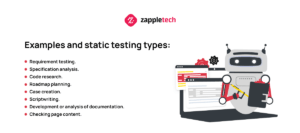
Static testing in software plays a crucial role in the early stages of the software development lifecycle (SDLC). By examining code, requirements, and design documents without actually executing the program, static testing helps QA specialists find bugs and identify potential issues before they become significant problems. This process not only improves the overall quality but also saves the project’s budget, reducing time and resources from the first day of work. Static and dynamic testing together provide a comprehensive approach. While static testing focuses on reviewing and analyzing code structure, dynamic testing involves executing the code to evaluate its behavior in real-time. The combination of static vs dynamic testing ensures that both internal and external errors are caught, ensuring more robust software functionality and performance.
Static Testing Methods:
Review: The tester’s task is to review the document and leave comments on it.
Analysis of technical specifications: comparison of tasks and theoretical methods for their solution. This includes reviewing specs by the team, planning test milestones, creating a roadmap, list of tests and scenarios.
Instruction: the project leader meets the performers and explains the tasks and nuances. They also answer questions and analyze the comments of the participants.
Validation: A specific IT product is examined to find inconsistencies, problems, bugs, or artifacts.
Code analysis: an example of a white box method. The code is checked for errors, bad syntax, or other technical problems. The bottom line is to compare the actual performance with the required.
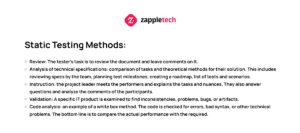
Static and dynamic testing techniques both offer several advantages, including simplicity, speed, and reliability. Static testing, for instance, allows for early detection of bugs without executing code, saving resources and time. It can be conducted from the very first stages of development, ensuring that issues are caught before they escalate, regardless of the project’s readiness. On the other hand, dynamic testing involves running the software in real-time to identify functional and performance issues. Together, these methods create a robust testing framework that ensures a comprehensive evaluation of both code quality and functionality throughout the software development lifecycle.
Dynamic Testing
Dynamic testing involves the evaluation of a software application’s functionality in real-time while it is in use. This process is crucial for identifying errors, bugs, and performance issues that occur during the operation of the application or one of its components. Unlike static testing, which focuses on reviewing the code, documentation, and design before execution, dynamic testing requires the software to be executed in a live environment.
One of the main advantages of dynamic testing is its ability to verify the software’s behavior under actual operating conditions. This can include testing individual functions, the user interface, or complete modules, ensuring they interact properly within the system. The primary goal of dynamic testing is to uncover any hidden defects that might not have been detected during static testing.
Once the code is running, dynamic testing helps ensure that the software performs as expected, identifying issues that only arise during runtime.Mikhail BodnarchukCDO, ZappleTech Inc.
In dynamic testing, both manual and automated methods are used. Testers often employ test cases based on user requirements to validate the expected outcomes. For example, they simulate user interactions to ensure that the app responds appropriately. This helps detect issues such as incorrect output, performance bottlenecks, or security vulnerabilities.
While static testing focuses on analyzing the software without execution, dynamic testing allows testers to interact with the running system, making it essential for validating an application’s overall functionality. This complementary approach helps deliver a robust and error-free final product.
Dynamic testing includes:
Modular: a specific module or finished app fragment is tested directly by the developer. Requires knowledge of the development language and understanding of coding, architecture, and compilation basics.
Integration: a comprehensive check of the attached modules to the system. The main goal is to identify and eliminate errors that occur when synchronizing code fragments.
System: all disparate components are brought together and integrated into the body of the program for a comprehensive test. The purpose of the test is to determine the application’s health and its compliance with the specifications.
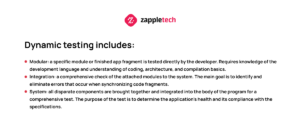
Dynamic testing plays a crucial role in the development of mobile, desktop, and web applications by ensuring the quality and functionality of the final product. It involves executing code in a real-time environment to identify any potential issues that might arise during actual usage. This process is integral to improving the level of usability, which directly impacts user satisfaction, customer retention, and ultimately, the business’s profitability. A well-executed dynamic testing strategy can significantly boost the success of an IT solution, leading to increased income and faster return on investment.
When combined with static testing, which involves reviewing the code without executing it, QA teams can achieve a comprehensive understanding of both the functional and structural quality of the software. Static and dynamic testing complement each other to ensure that no critical issues are missed, providing a robust testing framework that enhances the overall reliability and performance of the application. This balanced approach is why including both static and dynamic testing in QA services is essential for delivering a high-quality, successful product.
Main Differences Between Static and Dynamic Testing Types
Since the basic principles of static and dynamic testing are very different, so are the approaches, techniques, and tools used in each. Static testing focuses on reviewing code, documents, or project requirements without actually executing the code. This type of testing often involves static analysis tools or manual code reviews, which are typically conducted by developers, QA engineers, or even peer programmers. It helps to identify potential bugs or issues early in the development process, before the code is run.
On the other hand, dynamic testing requires executing the software and interacting with the application to validate its functionality. This type of testing is generally performed by testers who observe how the software behaves in real-world scenarios, checking for bugs that only emerge during runtime. The key difference between static and dynamic testing is that while static testing finds defects in the code itself, dynamic testing identifies issues that occur when the code is actually running.
In short, while static testing can involve early-stage activities like reviews and inspections, dynamic testing is focused on execution and real-world behavior, and each has its unique role in ensuring the quality of a product.
Let’s take a closer look at the difference between the two types.
Type | Static testing | Dynamic testing |
Compiling and reproducing code | Not required | Conducted on ready-made emulated fragments |
Purpose | Early testing of code, documentation non functional testing, and validation testing of specifications | Multi-step app testing with cycle updates at each functional testing sprint |
Task | Preventing and eliminating bugs before development begins | Finding, localizing, and neutralizing errors during the early stage of development system testing of an IT solution |
What improves the type of testing | Analyzes source code, its cleanliness, quality and functionality | Identifies bugs, provides reports, controls, executing the program, code correction |
Dependencies | Tests depend on the checklist and require unconditional adherence to the planned plan | Verification relies on the described test cases, scripts, and scenarios, which determine the testing vector of a fragment |
Execution conditions | Finished code or specifications | Deployed test environment, emulated environment, software system, or compiled program |
Test coverage | Covers, code review, documentation, and various white-box checks | Features, modules, integrations, relevancy of results, operability, and usability |
Cost | Relatively low | Expensive budget item |
Payback | High rate of return due to low investment and good performance | Medium or slow rate of return due to testing costs that start from later stages of software development, and continue even after the release of the IT solution to the market |
Benefits | The most relevant feedback, comments, recommendations, and user experience. A necessary element in verification checklist and process of quality testing | A high percentage of IT product cleaning from various bugs and errors, good efficiency of methods, and maximum app readiness for release after development. A mandatory component in testing |
Team meetings | Frequent meetings to synchronize efforts to analyze app problem areas | On average, fewer meetings are required because most work issues are resolved between sprints |
Summarizing
Cutting costs on QA can negatively impact the quality of your product, directly influencing its success in the market. Poor optimization and numerous bugs drive away customers, creating unfavorable conditions for business growth and damaging your brand’s reputation. Customers today expect seamless performance, and even minor bugs or performance issues can lead to poor reviews, decreased user engagement, and ultimately lost revenue. This is why it’s crucial to implement both static and dynamic testing techniques as part of a robust quality assurance strategy.
Static testing serves as a proactive approach, helping you identify potential issues in the code before the software is even executed. This method involves reviewing the code, design documents, and requirements to catch errors early in the development cycle. By doing so, you can prevent small issues from turning into costly problems down the line.
Combine both for maximum coverage – A balanced approach using both static and dynamic testing ensures thorough error prevention and detection, leading to a more reliable and high-quality product.Mykhailo PoliarushCEO, ZappleTech Inc.
On the other hand, dynamic testing ensures that the product behaves as expected when it is running. This technique is invaluable for detecting runtime errors, performance bottlenecks, and security vulnerabilities that could disrupt user experience. When static and dynamic testing are used together, they create a comprehensive safety net, catching both pre-execution and post-execution errors, leading to a more stable, reliable product. Investing in these QA methodologies not only reduces the risk of launching a flawed product but also improves the overall efficiency of the development process. Early bug detection through static testing saves valuable time, while dynamic testing guarantees that your product performs under real-world conditions. Together, these approaches help ensure that your product not only meets but exceeds user expectations, enhancing user satisfaction and increasing the likelihood of long-term success. At ZappleTech, we understand the importance of delivering a polished, high-quality product to the market. With our expertise in both static and dynamic testing, we ensure your IT solutions are optimized for peak performance, minimizing risks and maximizing returns. By choosing our comprehensive QA services, your startup or project will enter the market on time, fully optimized, error-free, and ready to outshine competitors. Don’t leave the success of your product to chance. Contact our manager today and entrust your QA needs to the experts at ZappleTech!
